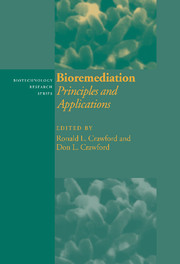Book contents
- Frontmatter
- Contents
- List of contributors
- Preface
- Introduction
- 1 Engineering of bioremediation processes: needs and limitations
- 2 Bioremediation in soil: influence of soil properties on organic contaminants and bacteria
- 3 Biodegradation of ‘BTEX’ hydrocarbons under anaerobic conditions
- 4 Bioremediation of petroleum contamination
- 5 Bioremediation of environments contaminated by polycyclic aromatic hydrocarbons
- 6 Bioremediation of nitroaromatic compounds
- 7 A history of PCB biodegradation
- 8 Bioremediation of chlorinated phenols
- 9 Biodegradation of chlorinated aliphatic compounds
- 10 Microbial remediation of metals
- 11 Molecular techniques in bioremediation
- Index
6 - Bioremediation of nitroaromatic compounds
Published online by Cambridge University Press: 28 October 2009
- Frontmatter
- Contents
- List of contributors
- Preface
- Introduction
- 1 Engineering of bioremediation processes: needs and limitations
- 2 Bioremediation in soil: influence of soil properties on organic contaminants and bacteria
- 3 Biodegradation of ‘BTEX’ hydrocarbons under anaerobic conditions
- 4 Bioremediation of petroleum contamination
- 5 Bioremediation of environments contaminated by polycyclic aromatic hydrocarbons
- 6 Bioremediation of nitroaromatic compounds
- 7 A history of PCB biodegradation
- 8 Bioremediation of chlorinated phenols
- 9 Biodegradation of chlorinated aliphatic compounds
- 10 Microbial remediation of metals
- 11 Molecular techniques in bioremediation
- Index
Summary
Introduction
Explosives and related compounds have become widely recognized as serious environmental contaminants. Among the nitrosubstituted aromatic compounds causing particular concern are 2, 4, 6-trinitrotoluene (TNT), 2, 4, 6-trinitrophenol (picric acid), and many nitro- and/or amino-substituted aromatics that result from the manufacture and transformation of explosives. The threat posed by the presence of these compounds in soil and water is the result of their toxicity and is compounded by their recalcitrance to biodegradation.
Contamination by nitroaromatic compounds, especially TNT, stems primarily from military activities (Boopathy et al., 1994). During the manufacture of explosives and the disposal of old munitions, large quantities of water became contaminated. This wash water was typically disposed of in unlined lagoons that facilitated the slow release of the explosives from the soil in the lagoons into ground water, lakes, and rivers.
The mutagenicity of TNT (Kaplan & Kaplan, 1982a; Won et al., 1976), as well as its toxic effects on algae and fish, humans, and other vertebrates, make it an environmental hazard (Hudock & Gring, 1970; Smock et al., 1976; Won et al., 1976). TNT has been listed as a priority pollutant by the U.S. Environmental Protection Agency (Keither & Telliard, 1979). Tan et al. (1992) compared the mutagenicity of the biologically reduced forms of TNT (2-amino-4, 6-dinitro toluene and 4-amino-2, 6-dinitrotoluene) to TNT, hexahydro-l, 3, 5-trinitro-l, 3, 5-triazine (RDX), octahydro-l, 3, 5, 7-tetranitro-l, 3, 5, 7-tetrazocine(HMX), and N-methyl-N, 2, 4, 6-tetranitroaniline (Tetryl) using the Salmonella/mammalian microsome plate incorporation method. They found that the reduction of the nitro groups of TNT to the amino products caused a decrease in the mutagenic activity of the compounds proportional to the number of amino groups formed.
- Type
- Chapter
- Information
- BioremediationPrinciples and Applications, pp. 195 - 208Publisher: Cambridge University PressPrint publication year: 1996
- 5
- Cited by



